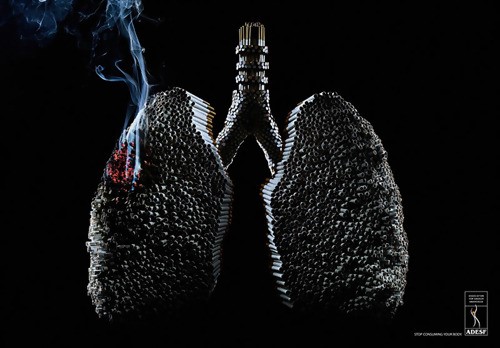More than 443,000 deaths occur annually due to smoking-related illnesses in the United States only, according to the Centers for Disease Control. In addition to costing the economy of the U.S more than 496 billion every year in healthcare expenses, the habit harms every body organ devastatingly.
Smoking causes lung disease, lung cancer, heart disease and stroke among other illnesses. The most disheartening thing about smoking is that most smoking-related illnesses and deaths can be avoided. Reduction in the rates of smoking is linked to a direct lifesaving effect, not just for smokers, but for individuals that suffer secondhand smoke exposure too.
When designing adverts for anti-smoking campaigns, ad designers have gone over decency limits to create ads that have shocked the audience. It’s, therefore, not surprising that anti-smoking campaigns that touch on lung cancer and other related subjects seem gruesome and scary. But, these inventive anti-smoking campaigns have managed to convey their message. They have also managed to convince some people to switch from smoking to vaping with devices that may use the best 510 thread battery from vapingdaily to vaporize the ingested product instead of burning the way traditional cigarettes do.
But, why would someone switch from smoking traditional cigarettes to vaping? Is vaping not the same as smoking a traditional cigarette?
How Vaping Differs from Smoking Traditional Cigarettes
It’s no secret that the popularity of vaping is increasing. Vaping is the use of an electronic device, known as an electronic cigarette or vape, to heat a liquid, called e-juice and then inhale and exhale the produced vapor. Using the device may simulate a traditional cigarette. This makes a person feel like they are smoking a traditional cigarette when they use an electronic device that may use a 510 thread battery to heat an e-liquid.
An electronic cigarette comes with a cartridge of the vaporized fluid. This fluid contains solvents, nicotine, and flavors. Most devices have refillable fluid cartridges. The battery is responsible for powering the heating element. This, then, vaporizes the e-liquid. Although the first generation e-cigarettes resembled traditional cigarettes, modern devices have different styles, shapes, and sizes. This partly explains their increasing popularity.
According to the National Institute on Drug Abuse, there are over 460 e-cigarette brands in the current market. These devices have varying nicknames but they mostly have the same functionality. The only difference is that some have more features than others.
What makes vaping different from smoking is that no combustion is involved when a person uses an electronic cigarette. As such, no smoke is produced when an individual vape. Instead, a vapor is produced and inhaled. That’s because vaping entails the vaporization of an e-liquid or e-juice. This liquid turns into a vapor when heated at a higher temperature.
Smoking, on the other hand, involves combustion. That means a smoker inhales smoke from a burnt material. When an herb or tobacco is burnt, smoke is its byproduct. Therefore, smoke contains more harmful compounds than vapor. This explains why some people consider vaping potentially safer than smoking.
Examples of inventive Anti-Smoking Campaigns
Several anti-smoking campaigns have managed to convey their message clearly and effectively. Their effectiveness is shown by their ability to lower smoking rates and convince some people to switch from smoking to use devices like those using the best 510 thread battery for cartridges to vape. Here are examples of such campaigns
1. Anti-Smoking Helpline
This is an inventive anti-smoking campaign ad because of its attention-grabbing twist. Created in 2008, this ad is quite creative. Gauging the effect of adverts on smoking rates may be difficult to isolate from the other factors that can influence the habit, such as high cigarette tax rates and smoke-free public places. However, such anti-smoking ads can convince some people to lower their smoking frequency or quit.
2. World No Tobacco Day
This is an anti-smoking ad campaign from China. It uses fear to deter people from smoking. And, this is not the only ad that is employing fear to deter people from engaging in this habit. The advertising landscape is cluttered and having a health-related ad make the desired impact can be difficult. Therefore, health organizations are using fear as a tactic to scare the audience into taking the desired action. When a person sees this ad, they may be tempted to start using the best 510 thread vape pen to avoid the dangers of traditional smoking.
3. Associação de Defesa da Saúde do Fumante (ADESF)
This is an inventive anti-smoking campaign ad. It is both chilling and artistic. This ad was designed for ADESF. The entity communicates the side effects of cigarette smoking. It’s alarming but it has the potential to make some people quit smoking fearing the side effects of smoking. It may seem frightening but not more than the effects of smoking.
With such an ad in mind, a person can easily think about investing in the best 510 vape pen to make a switch from smoking to vaping.
4. National Health Service (NHS)
Adverts like this prominently featured on radio, billboards, and TV channels in the UK. The aim of this anti-smoking campaign targeted young people that were not inspired to change their behavior. USA and Canada have also had similar anti-smoking advertising targeting the youth. The basis of such campaigns is the fact that most young people can be motivated when fears that relate to their fertility and sex appeal is used in ads.
5. Cancer Patients Aid Association
This is a powerful and inventive anti-smoking campaign ad that can prompt a person to quit smoking or invest in a 510 thread vape pen a way to start the quitting process. The effectiveness of this advert can be attributed to the fact that it includes small details like the lip gloss shown on the cup. It suggests that everything else may fail but a smoker remains a slave of their habit.
The Bottom Line
Research has shown that anti-smoking campaigns work when the media is used to convey the message. Such ads are effective in conveying a message that prompts smokers to reduce the number of cigarettes they smoke per day or give up the habit. A person can be prompted to invest in a device that uses the best 510 battery to heat e-juice instead of burning an herb. That way, they can avoid the negative effects of the smoke from the traditional cigarette smoke.






